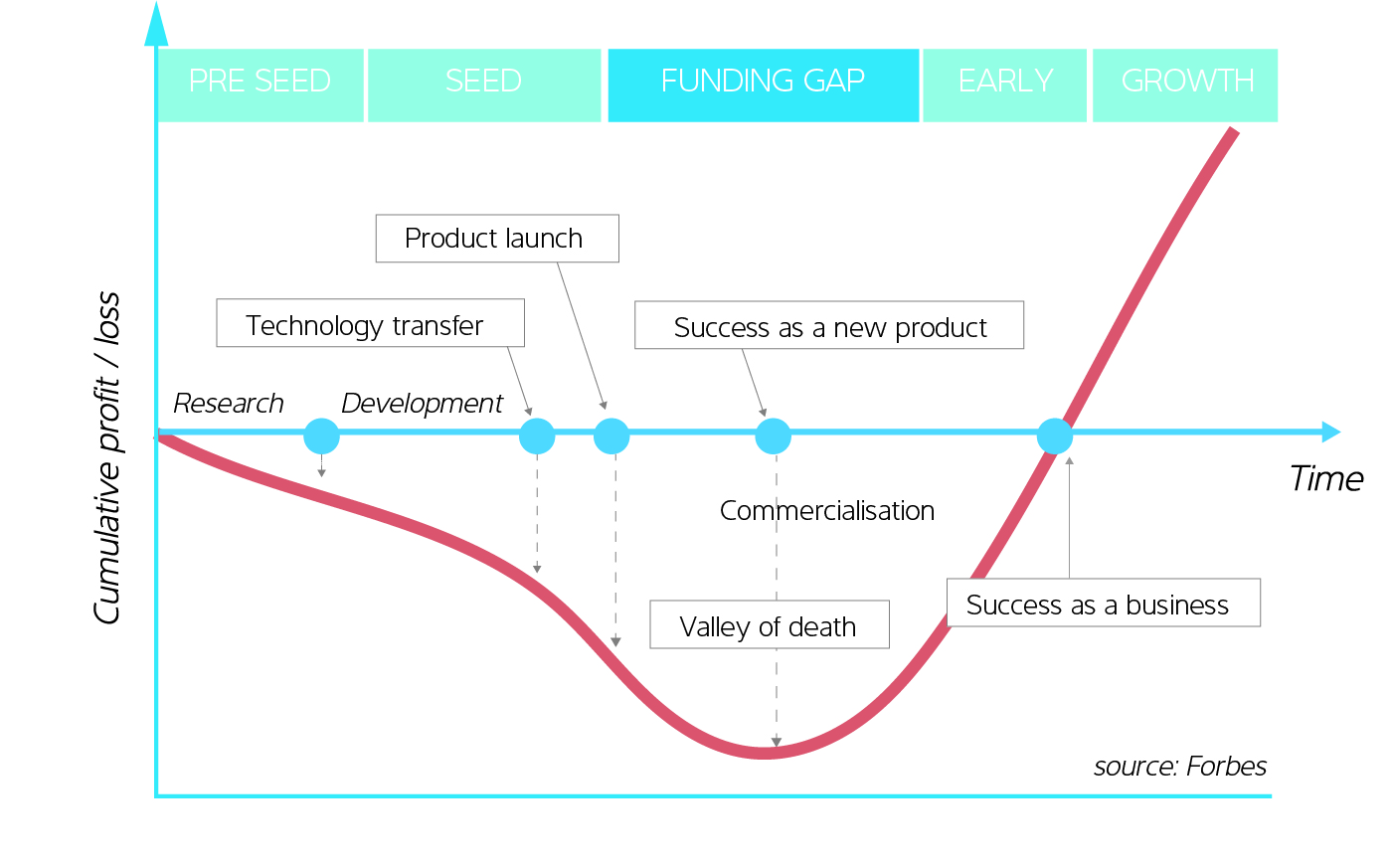Every innovation goes through the Valley of Death…always…every single time. This applies as equally to SMEs and Enterprises as it does to Startups.
Most Startups are aware of the Valley of Death concept, however, very few more established businesses realise precisely how and where this is occurring in their business right now, and how it is impacting them.
It is very rarely understood what the real challenges are with the valley of death.
For those that are not aware here’s a classic image of the valley of death “VOD”.
As the diagram shows, the VOD, is a representation of the different phases an innovation project goes through from idea to commercial scale success, versus the financial benefit/ cost it incurs during the journey from idea to commercial success.
Following are some of the key issues that are often misunderstood with the journey through the VOD.
Time is the most important factor in the VOD
The most serious and substantial mistake with misunderstanding the VOD, is not the depth of the valley, its the length. It is not the lack of water that kills a person, it’s how long they don’t have the water that kills them.
This is the same as what kills a business. A business may have a short term dramatic cash gap, but as long it has a budget for how to recover and that the budget will resolve the cash gap very quickly, the business will normally trade through the VOD.
On the other hand, when a business has only a small negative cash balance, but has no budget to resolve the negative balance and the negative balance continues for an extended period of time, the business will not be able to trade out of the problem and will need to close.
Therefore, when an innovation project does not run smoothly, it takes twist and turns, hits delays and roadblocks, the length of time it takes to get out of the VOD extends and thus its likelihood of recovering from its lack of water, starts to get very serious.

Will the benefit be worth the effort?
For an Innovation project to be worth the effort, it needs to generate substantially more cash over time, than the total cash spent in bringing the project to market.
An innovation project’s total cash spend is not recovered until it has past the point where the cash recovered is greater than the cash spent.
This is important to understand, it’s not a one off “break even” status where income in a period is greater than costs for the same period, its the point at which the total cash recovered is greater than the cash that has been spent on the entire project to date. This is commonly misunderstood and what many founders and innovation managers don’t realise until they look back on their project, rather than budget and look forward when they start or at regular stages of the project. The whole point of undertaking any business activity is to achieve a greater cash return than the cash spent, effectively this is the return on investment ratio of a project.
Therefore, what a business owner and innovation manager must do at the beginning and throughout the innovation journey is to have a cost versus return budget and revisit it constantly to ensure that there is an appropriate cost versus benefit ratio for the project.
The VOD is not just a startup concept
The next common misunderstanding is that the VOD doesn’t just apply to startups…it more than equally applies to every business undertaking any kind of innovation.
The challenge with innovation in an existing business is that it is very rare to find a business that correctly allocates all of the costs of the VOD to an innovation project when it is budgeting and as the project progresses it slowly starts to understand that the costs of the innovation project are much more than just the direct R&D costs.
Innovation projects require substantial time input from leaders and experts across an organisation, which are rarely included in the initial budget. And as the project progresses, the commercialisation costs start to increase before a substantial return is achieved, again this is not normally part of the initial budget.
Even if the project manages to make the financial returns it estimated, because the costs were not correctly budgeted from the beginning, the profit return will be greatly diminished for the project, which will obviously negatively impact the overall profit for the company.
This can have disastrous impacts on a previously successful business when the innovation project drains financial resources before the leaders realise that the innovation is costing them much more than the budget contains.
Are you making the RIGHT decisions?
It is not a question of whether an innovation project will go through the VOD, the question is will it get out? And getting out of the VOD is about making continuous good decisions. As we have found when assessing what successful and unsuccessful innovation looks like, the similarity is always around what decisions were made from beginning to the end.
At The Unleashed Zone we have created a unique Diagnostic framework that businesses use to continue to analyse and assess where they are, where they want to be and what they need to do next in order to get there in the most optimal way. The optimal innovation journey is the path of least resistance through the Valley of Death.

Steve Carroll, Founder of The Unleashed Zone | theunleashedzone.com
With over 20 years of experience in the innovation space, Steve has worked with thousands of businesses across a diverse range of industries, from start-up innovators to large multi-national corporations.
He founded The Unleashed Zone to help business owners and innovators achieve greater success, more efficiently, from their innovation.
